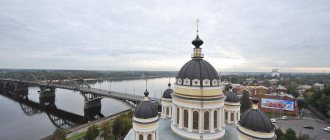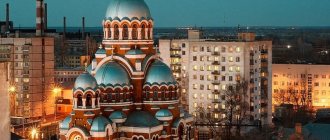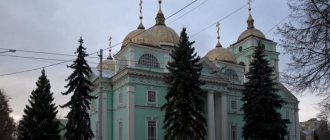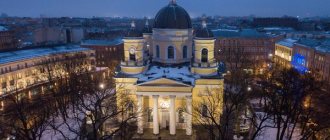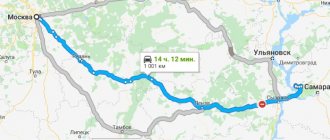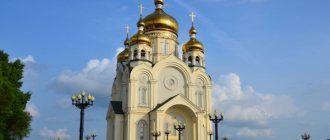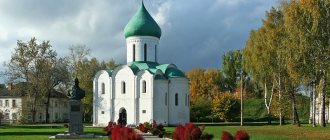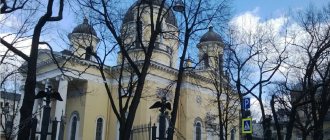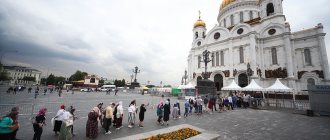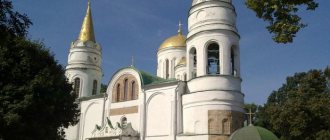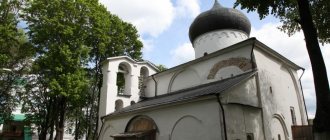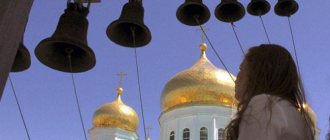Mir
Russia Belgorod Region Belgorod Spaso-Preobrazhensky Cathedral (Belgorod) Map is loading…
{"format":"leaflet","minzoom":false,"maxzoom":false,"limit":50,"offset":0,"link":"all","sort":[""], "order":[],"headers":"show","mainlabel":"","intro":"","outro":"","searchlabel":"\u2026 \u0441\u043b\u0435\ u0434\u0443\u044e\u0449\u0438\u0435 \u0440\u0435\u0437\u0443\u043b\u044c\u0442\u0430\u0442\u044b","default":"","import-annotation":false,"width ":"auto","height":"350px","centre":{"text":"","title":"""link":"""lat":50.598444999999998117345967330038547515869140625,"lon": 36.588560999999998557541402988135814666748046875,"icon":""},"title":"","label":"","icon":"","lines":[],"polygons":[],"circles":[ ],"rectangles":[],"copycoords":false,"static":false,"zoom":8,"defzoom":14,"layers":["OpenStreetMap"],"image layers":[] ,"overlays":[],"resizable":false,"fullscreen":true,"scrollwheelzoom":true,"cluster":false,"clustermaxzoom":9,"clusterzoomonclick":true,"clustermaxradius":80, "clusterspiderfy":true,"geojson":"","clicktarget":"","showtitle":true,"hidenamespace":false,"template":"","userparam":"","activeicon": "","pagelabel":false,"ajaxcoordproperty":"","ajaxquery":"","locations":[{"text":"\u003Cb\u003E\u003Ca href=\"/palomnik/%D0% A1%D0%BF%D0%B0%D1%81%D0%BE-%D0%9F%D1%80%D0%B5%D0%BE%D0%B1%D1%80%D0%B0%D0%B6 %D0%B5%D0%BD%D1%81%D0%BA%D0%B8%D0%B9_%D1%81%D0%BE%D0%B1%D0%BE%D1%80_(%D0%91% D0%B5%D0%BB%D0%B3%D0%BE%D1%80%D0%BE%D0%B4)\» title=\»\u0421\u043f\u0430\u0441\u043e-\u041f\u0440\ u0435\u043e\u0431\u0440\u0430\u0436\u0435\u043d\u0441\u043a\u0438\u0439 \u0441\u043e\u0431\u043e\u0440 (\u0411\u0435\u043b\u0 433\u043e\u0440\u043e\u0434 )\u003E\u0421\u043f\u0430\u0441\u043e-\u041f\u0440\u0435\u043e\u0431\u0440\u0430\u0436\u0435\u043d\u0441\u043a\u0438\u043 9\u0441\u043e\u0431 \u043e\u0440 (\u0411\u0435\u043b\u0433\u043e\u0440\u043e\u0434)\u003C/a\u003E\u003C/b\u003E","title":"\u0421\u043f\u0430\u0441\ u043e-\u041f\u0440\u0435\u043e\u0431\u0440\u0430\u0436\u0435\u043d\u0441\u043a\u0438\u0439 \u0441\u043e\u0431\u043e\u0440 (\u 0411\u0435\u043b\u0433\ u043e\u0440\u043e\u0434)","link":"","lat":50.598444999999998117345967330038547515869140625,"lon":36.588560999999998557541402988135814 666748046875,"icon":""}],,"imageLayers":[]}
50.598445; 36.588561
Russia, Belgorod, Preobrazhenskaya street, 63B
Belgorod, Belgorod region 308009
Russia
Telephone.:
8 (4722) 32-01-82
Email:
Transfiguration Cathedral
- Orthodox cathedral in Belgorod, built in 1813. The main church of the Belgorod and Stary Oskol diocese.
History[edit]
The Transfiguration Church was built in 1807-1813 according to the design of the Kharkov architect Evgeniy Alekseevich Vasilyev with the money of parishioners on the site of a dilapidated wooden church.
In 1923, after the closure of the ancient Trinity Cathedral, the Transfiguration Church received the status of a cathedral. In the 1930s the temple was closed.
Divine services there resumed in March 1942, during the fascist occupation of Belgorod. After the liberation of the city, the city executive committee issued documents on the transfer of the Transfiguration Cathedral to the church community “for indefinite and free use.”
In 1962, the Transfiguration Cathedral was closed again, and the building was transferred to the local history museum. But the museum in this building was opened only in 1973 after the completion of repairs and redevelopment.
In September 1990, the gradual transfer of the cathedral to the Russian Orthodox Church began. On September 17, 1991, the relics of St. Joasaph were solemnly transferred to the Transfiguration Cathedral, with the participation of His Holiness Patriarch of Moscow and All Rus' Alexy II.
The interior decoration of the cathedral, made in the spirit of “new Russian splendor” at the turn of the 20th-21st centuries, is in blatant contradiction with the architecture of the temple - a monument of provincial Russian classicism.
History of construction
During its existence, the Transfiguration Church, together with the city of Belgorod, experienced periods of both prosperity and decline, going from a parish church to a cathedral.
Spaso-Preobrazhensky Cathedral of Belgorod
The temple, consecrated in honor of the Transfiguration of the Lord, existed in Belgorod since the 16th century in the area of modern Cathedral Square. By the beginning of the 19th century, the wooden building began to pose a danger to parishioners. And the nearby Elias Church could not accommodate believers from both parishes. In 1805, city and church authorities decided to build a new religious building.
Temples and monasteries of the Belgorod region
The land of the Belgorod region (Holy Belogorye) has been the spiritual center of Orthodox Russia for centuries, and the ancient Russian city of Belgorod is the spiritual outpost of the Belgorod region. The Belgorod-Oboyan diocese, with its center in the city of Belgorod, was formed at the Great Moscow Council in 1667 by order of Tsar Alexei Mikhailovich, the father of Peter the Great. The new diocese covered the territory of the present Belgorod, Kursk, most of the Kharkov, and also part of the Sumy regions. In the vast Belgorod-Oboyan diocese there were more than a thousand churches and 50 monasteries
. For more than two and a half centuries, Belgorod was the diocesan city of one of the largest dioceses in Russia.
Today in Belgorod there are many reminders of the great history of the city’s churches.
The incorrupt relics of St. Joasaph are kept in the Transfiguration Cathedral; the St. Nicholas Cathedral bears his name. The ancient Holy Trinity Monastery and the cathedral of the same name were located in the very center of Belgorod on the site of the Belgorod Kremlin built in 1650. The main church of the Belgorod diocese was the Holy Trinity Cathedral. It was in it that the two main shrines of the Belgorod-Kursk region were kept: the incorruptible relics of St. Joasaph and the miraculous icon of Nicholas the Ratnoy. Now they are in the Transfiguration Cathedral.
Local residents and pilgrims from all over Russia came to the cave to venerate the incorruptible relics and receive healing. The second main shrine of the Belgorod land, located in the Holy Trinity Cathedral, is the miraculous icon of Nicholas the Ratnoy. This icon is over 500 years old and many different miracles are associated with it. A block from the former Holy Trinity Monastery on Pushkin Street there is the Marfo-Mariinsky Convent, and in it there is a unique monument of architecture and culture - the Assumption-Nicholas Cathedral.
Its uniqueness, first of all, lies in the fact that there are no similar churches in our region: not only in the Belgorod region, but throughout the entire south of Russia.
Such churches were erected in the north - in Arkhangelsk, Vologda, Kostroma, Yaroslavl provinces. On the territory of the Belgorod region, not a single building has survived, the construction of which began in the 17th century, which means that the Assumption-Nicholas Cathedral is the oldest building in the Belgorod region. Many churches of St. Belogorye
have an amazing history.
At the beginning of 1918, there were 1,253 monasteries in Russia, including bishops' houses (82), farmsteads (52), small monasteries (75), and the number of monks, nuns and novices in them reached 100,000. In the 20s, all monasteries were liquidated. In 1939-1940, as a result of the entry into the USSR of Western Ukraine, Western Belarus, Moldova and the Baltic countries, more than 100 monasteries appeared on the territory of the Union. Under Stalin, the number of monasteries decreased sharply. In 1958 there were 69 monastic monasteries, and in 1964 only 18 men's and 12 women's monasteries remained.
On the eve of the Millennium of the Baptism of Rus', the St. Daniel Monastery in Moscow, as well as the ruins of Optina Pustyn, were returned to the Russian Orthodox Church. At the end of 1987 - beginning of 1988, a new quality of Soviet church policy emerged, the essence of which was that atheists and believers should build socialism together. The millennium of the Baptism of Rus' marked a genuine change in Soviet religious policy and was the beginning of a massive restoration of churches.
The history of churches in the Belgorod region is inextricably linked with the general history of the Russian Orthodox Church. In 1873, in the Kursk Diocese, which included most of the territory of the modern Belgorod region, there were only rural churches: main 589, assigned 302, rectors 589, their assistants 348, psalmists 970. In 1908, services were held: in Belgorod - in 12 churches ; in Belgorod district - in 81 churches (of which 17 were wooden); in Grayvoron - in 4 churches; in Grayvoronsky district - in 69 churches (including 38 wooden ones); in Koroche - in 6 churches; in Korochansky district - in 80 churches (including 47 wooden ones); in Novy Oskol - in 2 churches; in Novooskolsky district - in 59 churches (including 34 wooden ones); in Stary Oskol - in 8 churches (including one wooden); in Stary Oskol district - in 65 churches (including 19 wooden ones). Before the revolution, there were 43 churches and a monastery on the territory of the Valuysky district (within its current borders).
Below are the temples and monasteries of the Belgorod region
both active and long-lost
Cathedral of the Smolensk Icon of the Mother of God (Belgorod)[edit]
A two-story brick church in the spirit of the Moscow Baroque, built in 1727-1763. The quadrangle of the main temple is completed with a small octagonal dome, and a bell tower is installed above the vestibule. In the 19th century was reconstructed in the classicist style. Below is the warm Smolensk Church, above is the Peter and Paul Church, the third throne of Michael the Archangel (1839). Closed no later than the 1930s, damaged by shelling in 1943. Since the 1980s it was restored as an organ hall, and in 1992 it was returned to believers. Restored to its original forms.
Thrones
: Smolensk Icon of the Mother of God
Year of construction
: Between 1727 and 1762.
Website
: https://www.smsobor.ru/
Address
: 308600, Belgorod, Civil Avenue, 50
Coordinates
: 50.595294, 36.5949
Church of the Exaltation of the Cross in Belgorod
The main shrine of the Belgorod Holy Cross Church is the miraculous Cross, dating back to the first half of the 18th century. The shrine was sent by a novice of the Athos Monastery to the landowner Yu. Vyrodov, his brother. Today this Large wooden Cross is located in a wooden icon case to the left of the iconostasis. It has a well-preserved ancient painting depicting the crucifixion of Christ.
The church itself was built in 1863 at the expense of merchants Nikolai and Yegor Mukhanov and Countess A.V. Lastovskaya. Today it is recognized as an architectural monument.
Schedule of services
Divine services in the Transfiguration Cathedral are held daily according to the following schedule:
- on weekdays two services are held at 8.00 and 17.00;
- from Monday to Friday at 13.00 they read an akathist to Saint Joseph of Belgorod;
- on Saturday and Sunday there are two morning services (7.30 and 9.30) and an evening prayer service at 17.00.
Divine service in the Transfiguration Cathedral
The cathedral is located at the address: Belgorod, st. Preobrazhenskaya, 63.
Church of the Pochaev Icon of the Mother of God (Belgorod)[edit]
Construction of the Church of the Pochaev Icon of the Mother of God began in April 2010 and lasted 1.5 years. On May 24, 2010, the foundation stone was solemnly consecrated.
The total area of the temple is 570.0 m2, height is 35 m (to the top of the cross).
On the sides of the Temple there are 4 small towers with domes, in the center there is a main tower with a dome with a diameter of -7.2 m, height - 6.7 m.
The area of the first floor, where services are held, is 240 m2, the height of the main hall is 13.5 m.
The temple is designed for 450 parishioners.
The main altar of the church is dedicated to the Pochaevskaya icon of the Mother of God, the side altar is dedicated to St. Spyridon, Bishop. Trimifuntsky.
On January 6, 2012, with the blessing of Archbishop John of Belgorod and Stary Oskol, the first All-Night Vigil was held, and on January 7, the first festive Divine Liturgy took place.
Address:
Russia, Belgorod, Yunosti Boulevard 3B
Telephone:
+7 (4722) 531359
Patronal holidays
On general church and patronal holidays, changes in the work of the church are possible, information about which should be clarified in the parish information service. The following holidays are celebrated with special pomp:
- August 19 - Transfiguration of the Lord;
- August 2 is the day of Elijah the Prophet;
- December 10 – icon of the Mother of God “The Sign”;
- September 17, December 23 - the day of remembrance of St. Joseph of Belgorod.
Shrines
As mentioned above, there are many shrines in the temple. The main ones are the following:
- relics of Saint Joseph the Wonderworker,
- Holy Face of Our Lady of the Sign,
- image of St. Nicholas the Ratnoy.
Parishioners simply fly in from all over the country to pray and bow before the saints. There are stories about them throughout the country about how icons helped many people in the most difficult everyday situations. There is a two-class Sunday school at the temple, where they study the holy letter, chants, etc.
It should be noted that today the Transfiguration Cathedral is considered an architectural monument. But despite this, Divine Liturgies are held there daily. Every year, at the end of each spring, a crusade procession to the neighboring village of Ustinka takes place with the icon of St. Mother of God “The Sign”.
Content
- 1 Transfiguration Cathedral (Belgorod)
- 2 Cathedral of the Smolensk Icon of the Mother of God (Belgorod)
- 3 St. Nicholas Cathedral (Belgorod)
- 4 Holy Cross Church (Belgorod)
- 5 Parish of the Holy Martyrs Faith, Hope, Love and Their Mother Sophia (Belgorod)
- 6 Temple of the Pochaev Icon of the Mother of God (Belgorod)
- 7 Church of St. George the Victorious (Belgorod)
- 8 St. Michael's Church (Belgorod)
- 9 Temple of the Archangel Gabriel (Belgorod)
- 10 Temple of the Korsun Icon of the Mother of God (Belgorod)
- 11 Church of the Life-Giving Trinity (Belgorod)
- 12 Temple of Sergius of Radonezh (Belgorod)
- 13 Temple of the Blessed Matrona of Moscow (Belgorod)
- 14 Holy Trinity Church (Belgorod)
- 15 Chapel of the Korsun Icon of the Mother of God (Belgorod)
- 16 Chapel of the Pochaev Icon of the Mother of God (Belgorod)
Temple of the Korsun Icon of the Mother of God (Belgorod)[edit]
The temple in honor of the Korsun Icon of the Most Holy Theotokos was consecrated by Bishop John of Belgorod and Stary Oskol on August 1, 1997.
The temple building, previously owned by one of the city's municipal services, was reconstructed.
The revered Korsun Icon of the Mother of God is kept in the temple, and not far from the temple there is a source, over which a chapel was erected in honor of the Korsun Icon of the Blessed Virgin Mary in 1995. From the same year, the tradition of religious processions to the source was resumed.
Address:
308010, Belgorod, Yachnevo, st. Portovaya, 94.
Telephone:
+7 (4722) 35-85-70
Official website of the temple
St. Michael's Church
An important architectural monument is the current St. Michael's Church, built in 1844 with donations from parishioners and funds from the Belgorod merchant M.K. Machurin in the suburban Belgorod settlement of Pushkarnaya.
This is a stone two-altar church, in which the main altar is consecrated in honor of the Archangel Michael, and the annex in honor of the venerable martyr Princess Elizabeth. Of particular interest is its four-tiered iconostasis, made in the mid-19th century in the Baroque style.
Temple of the Archangel Gabriel
Among modern Belgorod churches, it is worth noting the Church of the Archangel Gabriel, built on the initiative of the governor and consecrated in 2001. It is located on the territory of Belgorod State University, or rather, its campus. Today the church carries out important missionary activities, holding numerous conferences, seminars and lectures with students and teachers of Belgorod universities.
History of construction
According to historical facts, the temple was first mentioned in the 16th century. As described in the Chronicles, the temple would be rich in various holy faces and other church churches. Many historians are of the opinion that it was built in honor of the victory during the war with Napoleon’s army.
On the site where the temple was first built there used to be an old and dilapidated church. The newly built Transfiguration Church was a two-story building made of brick and stone. He had three limits. At a time when the Bolsheviks were fighting against the Orthodox religion on the territory of the USSR, the temple was closed, like many others.
The best article for you, go to: Ioannovsky Monastery on Karpovka
After its closure, it housed a local history museum. And only in the early 90s the building was returned to its original purpose. After which some work was carried out to restore it. In 1991, the first Divine Liturgy was held in the Cathedral.
